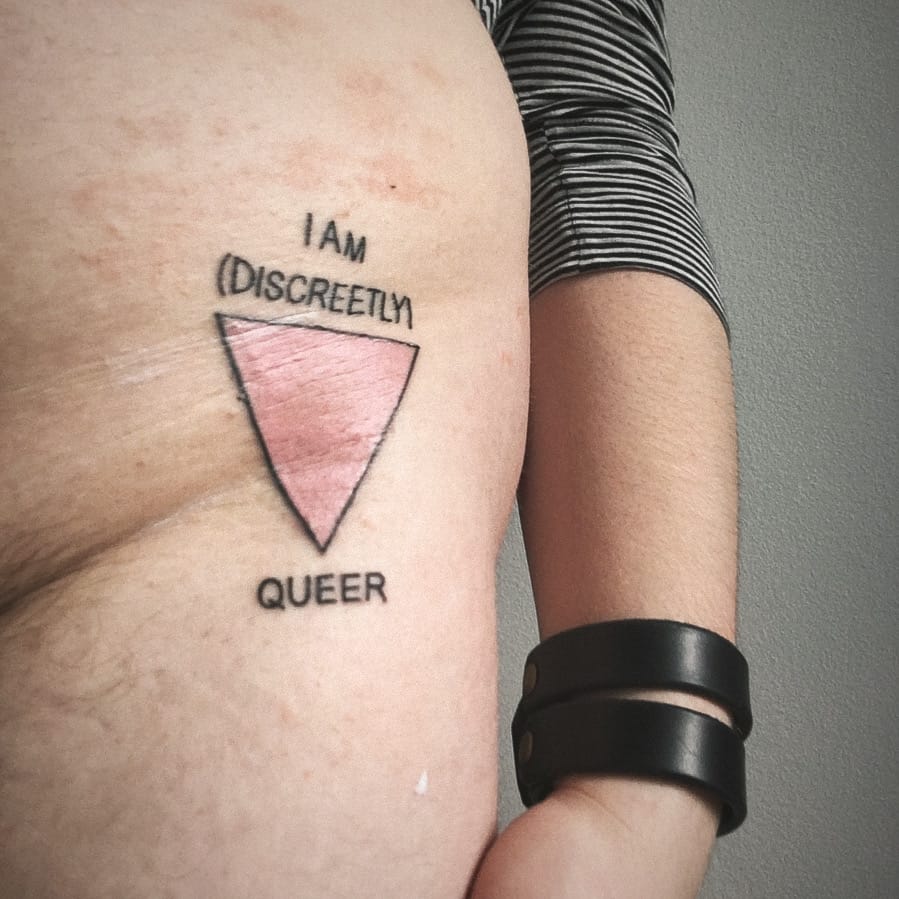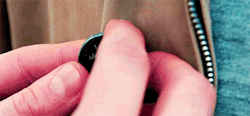Making my body more visibly queer

[CW: transphobia, discussion of Nazi concentration camps and historic persecution and erasure of queer and trans people]
Just a few days before my twenty-sixth birthday, I got a pink triangle tattooed on my left hip. A downwards-pointing pink triangle – the same symbol worn by gay men and trans people in concentration camps in the 1930s and 1940s.
Section 28 (which banned local authorities from “promoting homosexuality”) was repealed in Scotland in 2000 – a full three years before I started primary school. Despite that, I didn’t learn at school that queer people were among the groups persecuted by the Nazis when we studied the Holocaust. I probably didn’t learn about it until my early twenties, in the same way that I was in my late-teens before I properly learned about the homophobia-fuelled government inaction that led to the deaths of hundreds of thousands of queer people during the AIDS crisis.
It took me a while to stop feeling ashamed for my lack of knowledge about queer history, but I’m not embarrassed any more. Our history has deliberately been hidden – by queer people as self preservation, but also by those who benefit from being able to pretend queer and trans people are a new phenomenon.
You know why bigots can claim that puberty blockers and trans surgeries are “experimental”? It’s because records of the first trans healthcare clinic (Hirschfeld’s Institute of Sexology) were burned by the Nazis in 1933, along with an irreplaceable archive documenting the existence of trans, intersex, and queer people. We have always existed, even when people have tried to erase us.
The origins of the pink triangle as a queer symbol feel incredibly far removed from my first introduction to it. There’s a scene in the 2014 film Pride where one of the characters pins a badge to another’s jacket. It’s a small badge with a pink triangle on it, and the words: ‘I am (discreetly) gay’. I bought a copy of the badge the first time I visited Gay’s The Word in London – before I fully understood the weight of the history it holds.

It was the first time I wore something that visibly identified me as queer, and I wore it with pride and defiance. It’s unlikely that anyone noticed the pin on my t-shirt, but it still felt scary. It still felt like I was doing something that I shouldn’t, something I should be ashamed of.
The pink triangle was supposed to be a symbol of shame, but it was reclaimed by queer activists in the 1980s and 1990s. It feels powerful, as a queer man, to choose to put that symbol on my body. It not only connects me to pervious generations of queer and trans people, to my community’s history, but also a declaration that I cannot be separated from my queerness – and nor do I want to be.
While nowadays I’m less likely to be catcalled than called the t-slur, most of the time my body does not stand out as visibly queer. There is a privilege to being able to walk down the street exempt from the transmisogyny or queerphobia more visibly trans people experience – it’s important to me to acknowledge that. But my queerness and transness are the parts of myself I first and most easily fell in love with. I don't want to hide them.
It goes back, in some ways, to reading The Handmaid’s Tale by Margaret Atwood. I still vividly remember the chapter of the dystopian novel where Offred looks at the new bodies on the Wall, two of them with “purple placards hung around their necks: Gender Treachery.” I realised – even before I’d told another person that I might not be straight, long before I fully understood the pain and harassment and grief that comes with being trans – that I would rather be killed for who I am than pretend to be someone else.
At the time, I shamed myself for such a brash, unnecessary thing to think as a teenager who was only just figuring out his sexuality. I didn’t think that I lived in a world that would ignore my human rights, imprison me, or execute me because I am queer or trans. A decade later, and I’m just as bold as my younger self in my belief – the difference is that I now know that there are repercussions for refusing to be quiet about who I am.
I was right though: I would rather face those consequences than be forced to hide myself.
Much more recently, I learned something else about the persecution of queer men and trans people after the Nazi regime fell. You see, even when the war was over and the concentration camps were liberated, homosexuality was still illegal in Germany. And so those who survived the camps were sent back to prison. They were no longer being worked to death, but being queer was still a crime and they still had a sentence to serve.
Learning that destroyed the remaining shreds of faith my white, middle class upbringing had instilled in me that institutions and governments would protect me.
Today, even stripped of my t-shirts and pronoun pins and silver chain with ‘fag’ stamped on it, I am marked as queer. No one can take my queerness from me; I cannot and will not hide it. My transness is as much a part of me as my brown hair or eczema or how I cannot stop myself dancing to Taylor Swift. Perhaps it’s more so than any of those.
I spent January struggling with intense dysphoria about my chest. Whether it’s by surviving the NHS waiting lists or saving up a seemingly impossible amount of money to go private, top surgery is a long time away for me. But getting a tattoo was something I could do now to make my body more my own. Because even though I have to wait for healthcare that should be much more accessible, my body is already male. Why not show the world that?
My tattoo is a love letter to myself. It’s a promise. It’s a ‘fuck you’ to everyone who has made me ashamed of my queerness or told me that I should hide my transness.
It’s a reminder that no matter how many cis doctors have to diagnose me with a mental illness no longer recognised by World Health Organisation before I can get top surgery, they can’t actually dictate whether or not I am trans.
My body is already trans – and I get to exercise the bodily autonomy I do have to make it more visibly queer.



- I'm so glad Eli Cugini and Ilya Maude wrote about how social media can be a lifeline that connects trans youth to their community. Restrictions on phone use and more limits on children’s autonomy will harm young trans people, not help them. "Trans children are being attacked by their peers in public parks, beaten in school buildings, kicked out of quiet family homes. To continue to focus on “online” as the primary target of reform locates the problem not with transphobia, but with trans children themselves."
- Ella Dawson wrote about a new campaign that claims to be reclaiming the victim-blaming language of 'she's asking for it'. While she understands the intentions behind the campaign, Dawson points out that when people say 'she was asking for it', the 'it' is rape. "When people say 'she was asking for it,' they are not talking about sex. They are justifying a violent act. It is a permission structure. We can't reclaim 'asking for it' to promote affirmative consent because it was never about sex in the first place."
- Xtra published an extract from Gender/Fucking: The Pleasure and Politics of Living in a Gendered Body by Florence Ashley – which, let's be honest, I was probably going to buy from the title alone, but definitely will now. "The chaser gaze finds my transfeminine body enticing because it can never be female—and not because I am non-binary, since I wasn’t back then. No. It can never be female to them because it is the gender in-betweenness that makes me taboo and, thus, arousing."
- Talking of books: I had a massive (good!) cry at the end of Alice Austen Lived Here* by Alex Gino. It’s a middle grade book about found family and how queer people have always existed, and it includes MULTIPLE non-binary characters. I’m so glad books like this exist, but also I wish I could go back in time and give this one to my younger self. It felt so healing to read a story where young queer people find their voices to call out and push back against systemic cisheteronormativity.
- And either of the books above would make excellent choices for the Trans Writes Readathon – which started on Friday and is running until 29th March! Folks taking part are encouraged to read books by and featuring trans, non-binary, genderqueer, and Two-Spirit authors and characters, to talk about those books and authors on social media, and donate to and fundraise for trans aid organisations. Check out their Instagram and sign up if you want to get involved!
- Finally, you've also had a pretty shit week, I recommend checking out esteemed sex blogger Epiphora's video of her cat chasing and playing with tiny dildos:
